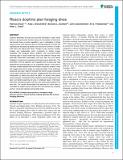Risso's dolphins plan foraging dives
Abstract
Humans remember the past and use that information to plan future actions. Lab experiments that test memory for the location of food show that animals have a similar capability to act in anticipation of future needs, but less work has been done on animals foraging in the wild. We hypothesized that planning abilities are critical and common in breath-hold divers who adjust each dive to forage on prey varying in quality, location and predictability within constraints of limited oxygen availability. We equipped Risso's dolphins with sound-and-motion recording tags to reveal where they focus their attention through their externally observable echolocation and how they fine tune search strategies in response to expected and observed prey distribution. The information from the dolphins was integrated with synoptic prey data obtained from echosounders on an underwater vehicle. At the start of the dives, whales adjusted their echolocation inspection ranges in ways that suggest planning to forage at a particular depth. Once entering a productive prey layer, dolphins reduced their search range comparable to the scale of patches within the layer, suggesting that they were using echolocation to select prey within the patch. On ascent, their search range increased, indicating that they decided to stop foraging within that layer and started searching for prey in shallower layers. Information about prey, learned throughout the dive, was used to plan foraging in the next dive. Our results demonstrate that planning for future dives is modulated by spatial memory derived from multi-modal prey sampling (echoic, visual and capture) during earlier dives.
Citation
Arranz , P , Benoit-Bird , K J , Southall , B L , Calambokidis , J , Friedlaender , A S & Tyack , P L 2018 , ' Risso's dolphins plan foraging dives ' , Journal of Experimental Biology , vol. 221 , no. 4 , 165209 . https://doi.org/10.1242/jeb.165209
Publication
Journal of Experimental Biology
Status
Peer reviewed
ISSN
0022-0949Type
Journal article
Description
Funding for the SOCAL-BRS project was provided by the Chief of Naval Operations Environmental Readiness Division, the U.S. Navy's Living Marine Resources Program, and the Office of Naval Research Marine Mammal Program. The Strategic Environmental Research and Development Program via a U.S. Army Corps of Engineers Contract (K.J.B. and B.L.S.) provided funding for data collection and prey analysis. This study was supported by the MASTS pooling initiative (Marine Alliance for Science and Technology for Scotland). MASTS is funded by the Scottish Funding Council (grant reference HR09011) and contributing institutions.Collections
Items in the St Andrews Research Repository are protected by copyright, with all rights reserved, unless otherwise indicated.

